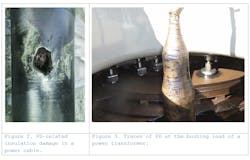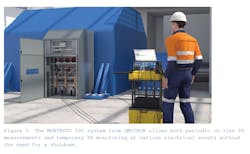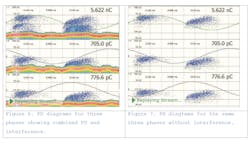Partial Discharge Testing and Monitoring Make Good Sense
The constant availability of medium- and high-voltage electrical assets used in power generation, transmission and distribution is important for a reliable power supply at both utilities and industrial plants.
Insulation faults are a major cause leading to the eventual breakdown and failure of assets, such as power transformers, motors and generators, as well as switchgear and power cables. Therefore, it is crucial that the insulation condition be verified throughout the asset’s lifecycle.
What is partial discharge?
Partial discharge (PD) is a consequence of local electrical stress concentrations in the insulation or on the surface of the insulation. PD is both a major cause and an indicator of developing insulation defects in electrical equipment.
With time, PD activity becomes more intense and dangerous. The process of deterioration can propagate and develop until the insulation is unable to withstand the electrical stress, leading to a flashover, costly asset damage and an unforeseen outage.
Why measure PD?
PD measurement is a reliable and non-intrusive method that can be used anytime to diagnose the insulation condition of an electrical asset. Compared with other dielectric diagnostic methods, PD detection through regular PD measurements and continuous PD monitoring collect very sensitive information to effectively detect localized weak points in the insulation system.
Because PD activity is often present well in advance of insulation failure, asset managers can assess it over time and make informed strategic decisions regarding the timely repair or replacement of the equipment before an unexpected outage occurs. PD detection is therefore essential to ensure the reliable, long-term operation of electrical equipment.
When should PD be measured?
The integrity of the insulation in MV and HV equipment should be confirmed with PD measurement and analysis during the development, manufacturing, and commissioning of electrical equipment.
Once the asset is in service, strategic decisions about maintenance must be made to ensure maximum availability. Periodic PD measurements and continuous PD monitoring provide asset managers with the required data to focus on at-risk assets and minimize unnecessary maintenance outages and costs.
Regular PD measurements performed during scheduled maintenance outages enable a trending of the asset’s insulation condition, which is a powerful way to recognize a developing insulation fault in its early stage and to plan maintenance accordingly to extend its service life.
The most important criteria for evaluating PD are:
• Charge level, measured in either picocoulombs (pC) or nanocoulombs (nC)
• Phase position related to the applied voltage
• Pulse repetition rate
An increase in any of these criteria between measurements indicates the presence of localized weak spots in the insulation, which can lead to further damage and eventual failure. Should increasing PD activity be detected, an on-line PD monitoring system can be used to keep an eye on its development over time.
How is PD measured?
PD measurements can either be performed off-line, by energizing each phase successively during standstill with a separate voltage source, or on-line with permanently-installed PD sensors during regular operation.
Off-line PD Measurement
For off-line PD measurements, a test voltage is applied that is slightly higher than the normal operating voltage. PD activity detected at pre-defined test voltage levels is recorded at each measuring sensor and stored for analysis. The test is successful if the PD value measured by the PD sensors is lower than the specified limit and no increasing tendency is observed during the test.
On-line PD Monitoring
On-line PD monitoring systems allow asset managers to continuously collect a vast amount of information without interrupting normal service. These PD monitoring systems record insulation condition data under real load conditions. Either temporary or permanently-installed PD monitoring systems are available to choose from. Both types of PD monitoring systems offer continuous on-line assessments of PD activity levels and insulation condition during time intervals specified by the operator.
Periodic Monitoring of PD Activity
Temporary PD monitoring enables operators to observe changes in PD activity over short, continuous periods of time. Temporary PD monitoring systems are designed for use with a variety of PD measurement sensors, including coupling capacitors for rotating machines, bushing tap sensors and UHF sensors for power transformers, as well as high-frequency current transformers (HFCTs) for power cables.
These PD measurement sensors can be permanently installed and connected via a terminal box, which is also permanently installed at the asset. This enables safe and convenient plug-and-play connections while the asset is on line to avoid unnecessary downtime during setup.
When one asset has been monitored, the temporary PD monitoring system can be easily moved to assess insulation condition in the next asset. With the monitoring software, asset managers can reliably assess the current insulation condition and identify which asset is most at risk of failure.
Permanent PD monitoring for high-risk assets
A permanent on-line PD monitoring system is typically used on critical assets and assets showing signs of aging to assess insulation condition for an indefinite time period under normal operating conditions. This type of PD monitoring system consists of permanently-installed PD sensors designed for the monitored asset, a data acquisition device as well as monitoring and PD analysis software running on a central computer. Multiple assets can be synchronously monitored at the same time and the data can be compared using the same software at the central computer. A warning or alarm is triggered to alert the operator when PD activity exceeds acceptable limits.
What are the measurement and monitoring challenges?
Since signals emitted from PD activity may be of low magnitude, it is crucial to use highly sensitive PD measurement and monitoring equipment. This, however, results in a higher susceptibility to interference from electronic noise. The elimination of this interference where possible is therefore critical for successful detection of PD activity.
With freely-selectable filtering options offered, for example by OMICRON’s PD measurement and monitoring systems, the measurement center frequency and bandwidth can be adjusted to achieve a high signal-to-noise ratio and a low level of background noise. Unique PD source separation tools, such as the 3-Phase Amplitude Relation Diagram (3PARD) and automatic cluster separation, simplify the differentiation of various PD sources from interferences for reliable analysis.
OMICRON has several years of experience in the field of PD measurement, monitoring and analysis on medium-voltage and high-voltage assets with customers in the asset manufacturing, power utility and industry sectors. More information is available at www.omicronenergy.com/partial-discharge-testing.
About the Author
Ole Kessler
Product Manager
Ole Kessler studied electrical engineering at the Berlin University of Technology. In 2009 he joined OMICRON Energy Solutions in Berlin where he started out as an application engineer specializing in partial discharge measurement. He also worked as a trainer, leading workshops on PD measurement for customers worldwide. He currently works as a product manager for the company’s MPD Series of PD measurement and analysis systems.





